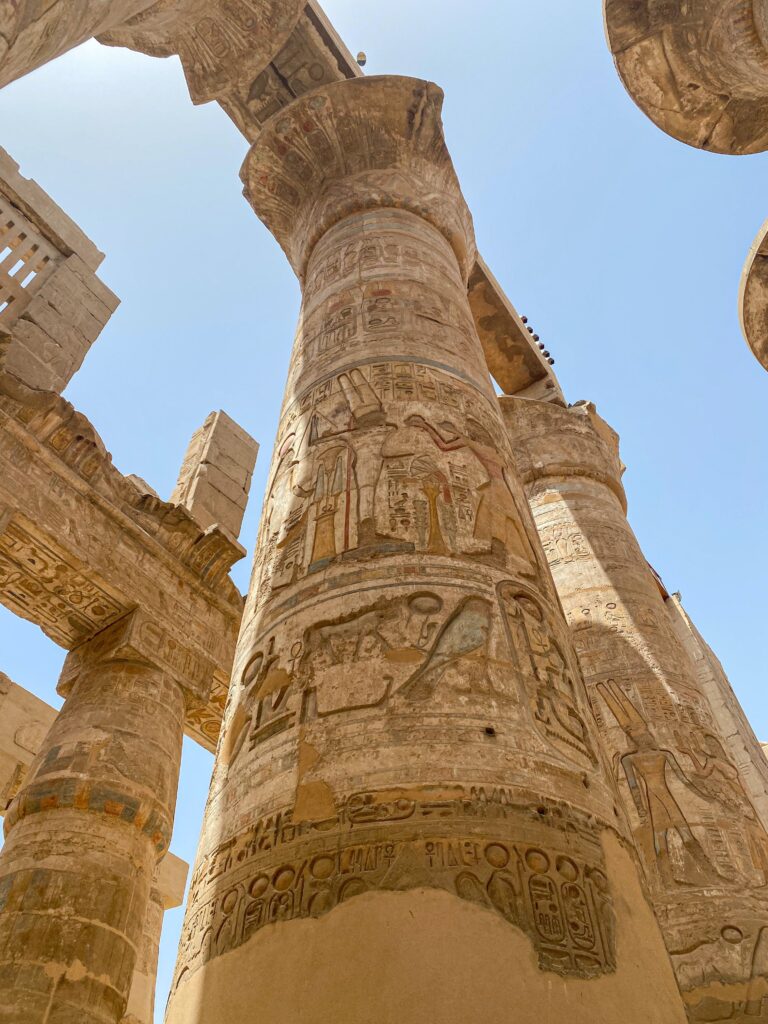
Illustration 1: Pyramids Gardens – Al Haram, Egypt. Photo from Pexels.
Welcome to this journey through time as we explore the monumental remains of a civilisation that left an indelible mark on architectural history: ancient Egypt. In this fascinating era, carving buildings in ashlar stone was not only structurally necessary, but served as artistic expression that has endured for millennia. Join us as we unravel the secrets of this unique technique and analyse its long lasting impact.
Stone Monumentality: An Enduring Legacy
Ancient Egyptian architecture stands out for its grandeur and the mastery with which the builders worked the stone. From majestic pyramids to intricately carved temples, ashlar stone was the primary material used to build these colossal structures.
The choice of ashlar stone was not simply pragmatic, it was an aesthetic and cultural decision. The durability and strength of the stone ensured the long-term preservation of these monumental structures. However, beyond its functionality, stone became a three-dimensional canvas for Egyptian craftsmen. Each carved block was not only part of an architectural structure, but also told a story.
In this way, monumentality in stone reflects a world view expressing immortality and connection to the divine. This was achieved through the solidity and permanence of the carved stone. Thus, ashlar masonry becomes a vehicle for artistic expression.

Illustration 2: – Person walking between columns, Egypt. Photo from Pexels.
Examples of Architectural Grandeur
Ancient Egyptian architecture is striking for its monumentality. Similarly, it stands out for the mastery with which builders worked the stone. From majestic pyramids to intricately carved temples, ashlar stone was the primary material used in these colossal structures. The durability and strength of the stone not only ensured the longevity of the buildings, but also provided a perfect surface for artistic expression through carving.
The Pyramids of Giza
The Pyramids of Giza rise majestically on Egypt’s sandy horizon, architectural beacons that have guided design evolution to the present day.
Built more than 4,500 years ago, these structures are a testimony to the technical and artistic skill of an ancient civilisation. Blocks of limestone and granite, carved with millimetre precision, are assembled to form one of the Seven Wonders of the Ancient World.
Influence on contemporary architecture
The Pyramids of Giza have had an undeniable influence on contemporary architecture. With its basic geometric shape, the pyramid has endured over time as a symbol of stability and grandeur. As such, the pyramidal structure has been reinterpreted and adapted to modern architecture. From corporate buildings to commemorative monuments its influence is evident. This iconic shape has proven its versatility and an ability to evoke a sense of power and permanence.
On a technical level, the pyramids have challenged modern engineers to decipher the exact construction methods used by the ancient Egyptians. The precision of the stone cutting and the exact alignment of the structures have baffled experts for centuries. As a result, they have inspired much research and debate about the techniques used in their construction.
In short, the Pyramids of Giza are not only historical relics, but beacons that show the way to architectural greatness. Consequently, their legacy serves as a reminder that architecture can transcend the ages and provide a source of inspiration over time.

Illustration 3. Photo of the Pyramid of Giza – Giza, Philippines Photo from Pexels.
The Temple of Karnak
The majestic Temple of Karnak stands on the banks of the River Nile at Luxor. It is an impressive monument to Egyptian stone carving mastery. Accordingly, this monumental complex extends over 60 acres. It provides a lasting testimony to the artistic skill and meticulous craftsmanship of the ancient Egyptian civilisation.
Constructed over the centuries by various pharaohs, the Temple of Karnak is an architectural masterpiece with unique features. Its imposing columns, some intricately carved in relief, testify to pharaonic ambition and skill in working stone on a monumental scale.
Serving as a vast open-air museum, the Temple of Karnak also narrates pharaonic myths and glories through its detailed reliefs. Walls and columns are adorned with hieroglyphics and divine figures, creating a tapestry that transports visitors back in time.
Influence on current architecture
Current architecture is clearly influenced by the Temple of Karnak, which is evident in the ongoing admiration it arouses. Thus the grandeur of its spaces and meticulous attention to detail have inspired modern architects and designers. The result is the creation of public spaces and buildings that seek to emulate the magnificence and visual narrative of Karnak.
In combining stone carving and reliefs, Karnak has influenced the contemporary approach to architectural ornamentation. This has led to the pursuit of artistic expression through carved stone, becoming a timeless trend. In this respect, the temple of Karnak continues to serve as a benchmark. By paying tribute to this ancient marvel, modern architecture demonstrates how timeless techniques and styles can endure and continue to inspire through the centuries.

Illustration 4. Photo of the Pyramid of Giza – Giza, Philippines Photo from Pexels.
Ashlar Masonry Today: An Endless Source of Inspiration
Ashlar stone carving is notable as an endless source of inspiration in the contemporary architectural landscape where innovation and diverse materials are the norm. Although construction techniques have evolved, this ancient technique continues to influence and manifest itself in fascinating ways in modern projects.
Ashlar stone carving was once the backbone of ancient architecture. Today, it has left an indelible mark on contemporary design. It is true that this technique is no longer directly replicated in construction today. Nevertheless, its essence endures in the appreciation of detailed craftsmanship and sculptural expression in modern architecture.
Influence on iconic projects worldwide
Landmark projects around the world incorporate elements that pay tribute to ashlar masonry. Sculpted façades, intricate reliefs and hand-carved details bear witness to this lasting influence. Furthermore, modern technology has produced a fresh take on ashlar masonry, adapting it to today’s standards and needs without losing its artistic essence.
In short, ashlar stone carving is not a forgotten technique. Rather it serves as a muse that continues to inspire architects to explore new ways of incorporating craftsmanship and visual narrative in the contemporary urban fabric.

